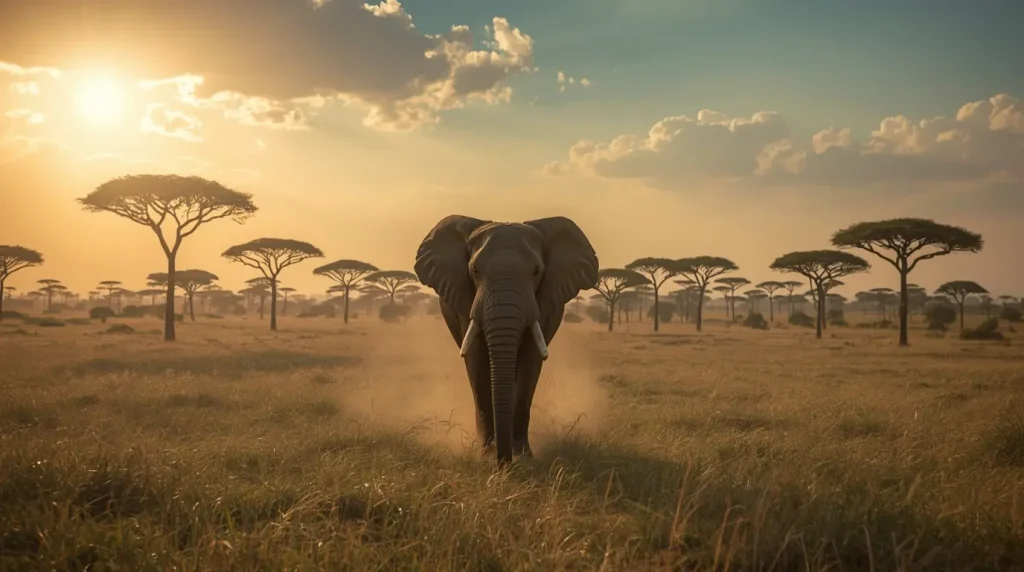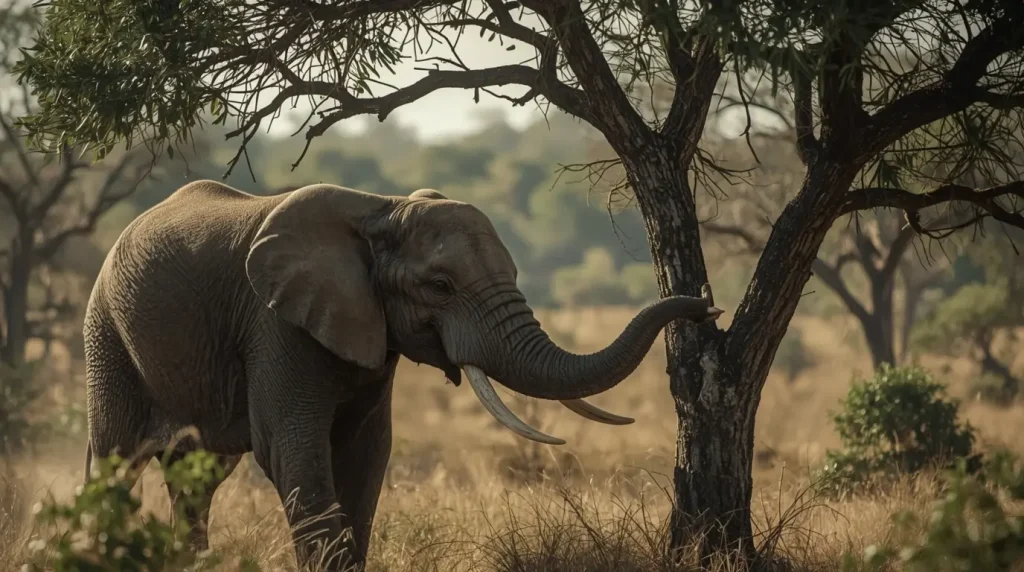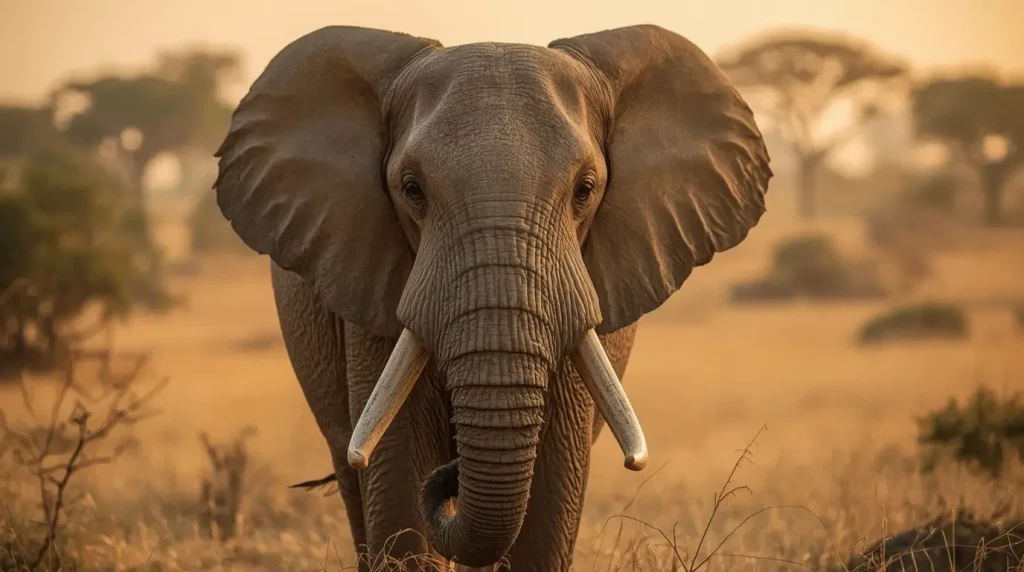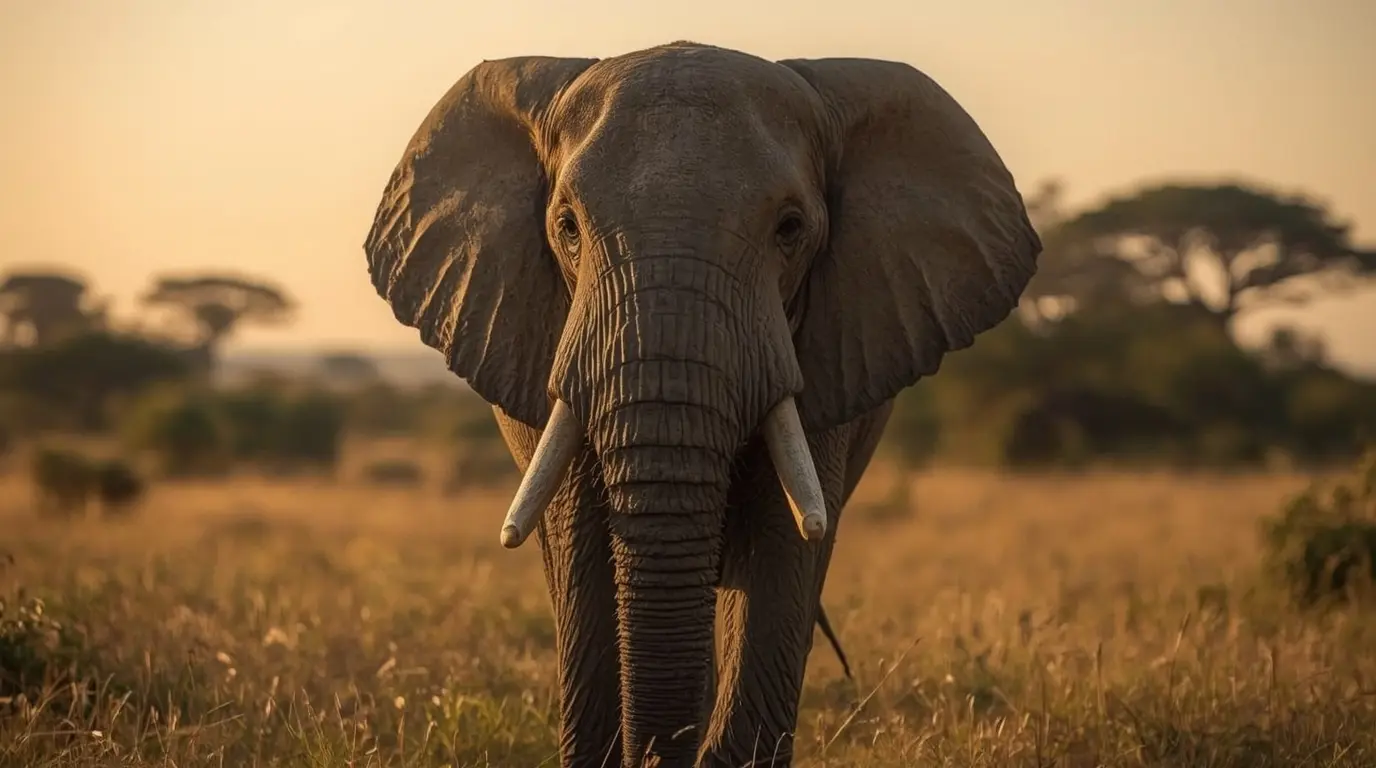As the first sunlight stretches over the African savanna, a true giant steps into the day. His tusks, each longer than a tall man, drag gently, etching soft, ancient letters into the golden sand. This is no ordinary bull; he is a super tusker, one of the last of a breed that is quickly fading into legend. His every footprint carries the weight of a remarkable fight for survival and is a vivid chapter in one of the most urgent conservation tales of our century.
At the heart of this battle is the term “super tusker,” a title we give only to the most breathtaking bull elephants. These animals boast tusks that tip the scales at over a hundred pounds each, the embodiment of unmatched genes. Growing tusks that grand takes decades, sometimes well past fifty birthdays, a testament to endurance in the wild.
When you stand in their presence, you step back in time; this is Africa as it existed generations ago. In this post, we journey deeper into the realm of super tusker elephants. We’ll see why their role in the ecosystem is priceless, discover the chilling dangers that stalk them, and celebrate the tireless warriors on the ground who refuse to let this remarkable heritage fade away.
What Exactly Defines a Super Tusker?
A super tusker gets its title from the perfect mix of age, genetics, and a bit of good fortune. The dramatic, long tusks come from a genetic trait that makes the ivory grow thicker year after year. To reach a super tusker age a bull must dodge drought, fight off disease, and, most dangerously, stay clear of human conflict. That’s why many researchers and conservationists give each super tusker a name; it’s easier to follow its travels, monitor its health, and tell those stories. In Kenya, the most famous super tusker populations roam the Tsavo and Amboseli ecosystems, where the rolling plains and dry hills stand as protective borders.
These giants hold powerful meanings beyond science. In the eyes of the local communities, and indeed the whole world, a super tusker is a living embodiment of natural history and ecological value. Their great size evokes respect and wonder; they remind everyone why keeping wild spaces intact is essential. Losing one super tusker doesn’t simply remove one majestic bull; it wipes out an entire strand of genetic history that took thousands of years to develop.
The Powerful Impact of the Super Tusker on Its Environment
The super tusker does more than steal the show wherever it roams—this majestic animal is a keystone species that quietly shapes the entire ecosystem. By being the gentle giants that they are, they influence nearly every living thing around them. Their very existence is a cornerstone on which much of the ecosystem is built.

An older super tusker has a memory that rivals our best maps. During years of extreme drought, it alone knows the secret wells where water still lurks miles away. By lumbering toward these hidden oases, the tusker calls out to a living caravan of younger elephants, lions in search of a drink, even birds trying to survive. Their journey safeguards the lifeblood of the landscape. When the tusker pushes down old, overgrown trees it clears the savannah, opening room for sun to warm fresh grasses that fuel migrating herds of zebra and antelope.
Every meal is a forward-planning strategy. The ts’ker crunches its way through ripe fruits, collapses a shower of undigested seeds, and travels miles before the seeds, now custom-wrapped in dung, magically fall in fresh-tilled soil guided by a smooth graze of the tusk. What was once fruit germinates and eventually holds the shape of forests and rain-soaked grasslands, extending the mix of plants that sustain the entire food web.
Though it may seem that the size and strength of the tusker alone shape the grasslands, the hidden maps recorded in its footsteps create hidden highways for antelope, the gentle shuffle of butterflies, and beetles that harvest nutrients in the tusker’s wake.
The Gentle Giants: Behavior and Social Structure
Unlike the hard-edged stereotypes some people hold, true super-tuskers tend to have cool heads even in the wild. After the wild storms of testosterone that young bulls face, the very largest elephants glide past that phase and usually adopt a calm, majestic poise. Close friend and veteran wildlife photographer Federico Veronesi, who has spent three annual cycles following the great bulls, regularly marvels at how tenderly they can move among herds without a single rumble of intimidation.
Though they mostly roam alone or in loose bachelors, the elder super tusker of legend, Craig, surprises field crews. Time and again guides catch him walking at a slow pace with young bulls who bump heads to learn the slow rhythm of old movers. Craig leads them to shaded wallows, identifies scarce scrub that quenches thirst, and even models the art of waiting silently while storms unwind overhead. Each mirrored move insinuates that wisdom, like ivory, is worth its weight in the elephant society’s culture-bound ledger.

The Conservation Battle: Protecting the Last Super Tuskers
The deadly sniper’s reticle now rides the flash of ivory rather than the bull itself. Every elongated tusk that marks a super-tuskers identity amounts to a crown-valued relic in the international black market, and the old x’s who revive the craving crown the poacher’s paycheck. The proclamations and empty embargoes from distant conferences have slowed, but human craving still leak, retail, and final kill. Each elephant’s survival becomes a sequential pressure of night drone patrols, days stewards, microchipped detectors, and decoy herds. The clock ticks in staccato heartbeats: life should never be a commodity, even wrapped in the last candle lines of tusks.
Thankfully, groups filled with fierce determination are on the ground making a difference. The Tsavo Trust, working hand-in-hand with the Kenya Wildlife Service (KWS), runs the “Big Tusker Project“ to shield our biggest, oldest elephants. Every single effort counts:
- Aerial Surveillance: Every month, light aircraft make low, slow sweeps over the park to spot and double-check the health of our biggest tuskers.
- Ground Teams: Elite ranger groups move quietly on foot, forming a protective ring around waterholes and migration routes to turn would-be poachers away while keeping a watchful eye on elephant herds.
- Community Outreach: The true backbone of the project is its engagement with nearby towns and villages. Through workshops and guided eco-tourism, residents learn how a single super tusker gets the world talking. In turn, this knowledge draws in visitor income, turning former poachers into safari guides and village champions.
The super tusker reminds us each day that every second matters. Each individual in the project has a personal dossier full of flights, tracks, and health notes. The planners move like silent chess pieces, making decisions to bless another day of life. Front-line stories would stay silent without photographers like Federico Veronesi. His heart-stopping images carry the elephants’ message around the planet, drawing fresh eyes, fresh tears, and fresh support.
How You Can Help the Super Tusker
Saving the super tusker isn’t just a job for the people of Africa; protecting this magnificent elephant is something everyone around the world can do. So let’s explore some simple yet powerful steps you can take right now:
Give the Right Kind of Support: Instead of broadly donating to any wildlife fund, focus your giving on groups that have boots on the ground protecting super tuskers. The Tsavo Trust works right in their home range, so any help is powerful. The World Wildlife Fund (WWF) also runs effective programs, so your cash can have a direct impact.
Go on a Big-Hearted Safari: Dreaming of an African adventure? Pick a tour company that put animal welfare and local people first. A responsible operator ensures you see super tuskers the right way, the elephant-rich area earns money for the community, and everyone benefits. Every safari can become another ticket to saving these giants.
Make Some E-noise: Stories need ears. The super tusker’s journey can spread through your social media feeds, group chats, and email lists. Just posting a photo, wildlife video, or quick message can reach thousands. When the world hears their name, decision-makers hear you, too, boosting the fight for stronger protections.
Push for the Big Rules: Strong, enforced international laws make the illegal ivory market a risky business. Write to lawmakers, sign petitions, and support campaigns that tighten trade controls. A stronger legal framework makes ivory a dangerous and unwanted commodity, protecting the super tusker and cutting the threat at the source.
Shielding a Worthy Heritage
The super tusker stands as more than an animal; it embodies a living archive of nature itself. These colossal elephants represent the wild possibilities our planet offers when left to flourish. Their massive tusks are irreplaceable heirlooms, and their fate is closely tied to the balance of entire forests and savannas. Today, united teams protect the last few super-tusked giants, and their diligent work delivers a glowing promise—proof that focus, cash, and worldwide friendship can stop the quiet goodbye of these gentle monarchs.

Together, we must keep that promise so our kids and their kids can still feel the earth’s deep humming thunder and the quiet thrill of facing a super tusker—a true living epic of the African continent.
Source: https://edition.cnn.com/world/africa/super-tusker-elephant-photos-federico-veronesi-spc
For more incredible stories of everyday news, return to our homepage.





